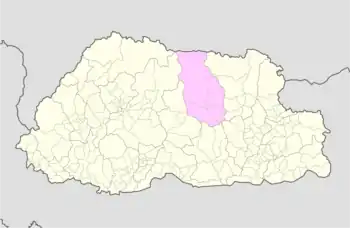Bumthang District
Bumthang district
བུམ་ཐང་རྫོང་ཁག | |
|---|---|
District | |
 Map of Bumthang District in Bhutan | |
| Country | Bhutan |
| Headquarters | Jakar |
| Area | |
| • Total | 2,717 km2 (1,049 sq mi) |
| Population (2017) | |
| • Total | 17,820 |
| • Density | 6.6/km2 (17/sq mi) |
| Time zone | UTC+6 (BTT) |
| HDI (2019) | 0.661[1] medium · 6th |
| Website | www |
Bumthang District (Dzongkha: བུམ་ཐང་རྫོང་ཁག་; Wylie: Bum-thang rzong-khag) is one of the 20 dzongkhag (districts) comprising Bhutan. It is the most historic dzongkhag if the number of ancient temples and sacred sites is counted. Bumthang consists of the four mountain valleys of Ura, Chumey, Tang and Choekhor ("Bumthang"), although occasionally the entire district is referred to as Bumthang Valley.
Bumthang directly translates as "beautiful field" – thang means field or flat place, and bum is said be an abbreviation of either bumpa (a vessel for holy water, thus describing the shape and nature of the valley), or simply bum ("girl", indicating this is the valley of beautiful girls). The name is said to have arisen after the construction of Jambay Lhakhang.
Economy



Bumthang farms yield buckwheat, dairy products, honey, apples, potato, rice, woolen products and many other products. Bumthang is rich in producing wheat, buckwheat, dairy products, and potatoes. Bumthang is also nationally famous for yatha and bumthna matha weaving.
Languages
East Bodish languages are primarily spoken in Bumthang District.[2]
The language spoken in the Bumthang district is known as Bumthangkha. It is a Tibeto-Burman language mutually intelligible with Khengkha and closely related to Dzongkha, the national language of Bhutan. Bumthangkha is partially comprehensible to speakers of Dzongkha, which originated in valleys to the west of Bumthang. Each of the four valleys of Bumthang has its own dialect, and the remnants of the Kheng kingdom, near and in Zhemgang District to the south, speak Khengkha. Historically, Bhumthangkha and its speakers have had close contact with speakers of Kurtöpkha to the east, Nupbikha to the west, and Khengkha to the south, to the extent that they may be considered part of a wider collection of "Bumthang languages."[3][4][5][6]
Brokkat, an endangered[7] Southern Bodish language, is spoken by about 300 people in the village of Dhur in Bumthang Valley. The language is a remnant of pastoral yakherd communities.[8][9]
Administrative divisions
Bumthang District is divided into four village blocks (or gewogs):[10]
Bumthang also contains several notable towns:
- Chhumey
- Prakhar
- Jakar - the district administrative headquarters
- Tang Valley
- Ura
Annual Jakar Tshechus:
- Mid October (every year)
Tandindang school was started on 17 July 2010, to benefit the children going to school.
Environment
Most of Bumthang District is part of Bhutan's extensive protected areas network. The northern two-thirds of the district (the gewogs of Chhoekhor and Tang) belong to Wangchuck Centennial Park, buffered by pockets of biological corridors. Southern Bumthang (the gewogs of Chhumig, Tang and Ura) is part of another protected area, Thrumshingla National Park.[11][10] Bumthang is known for its important population of black-necked cranes migrating in winter.
Landmarks
- Membartsho (Burning Lake), where sacred scriptures were hidden by Padmasambhava in the 8th century and later recovered by Pema Lingpa in the 15th century.
- Kurjey Lhakhang, the final resting place of the remains of the first three Kings of Bhutan.
- Jakar Dzong, adjacent to the main town of Jakar.
- Jambay Lhakhang, one of the two most ancient temples of Bhutan, built in the 7th century by Songtsän Gampo, founder of the Tibetan Empire.
- Tamzhing Monastery, the most important Nyingma institution in the country.
- Padtshaling Gonpa, The monastery was established by the first Padtshaling Tulku Siddha Namgyal Lhendub in 1769, according to the prophecy of Lhasa Jowo.
References
- "Sub-national HDI - Area Database - Global Data Lab". hdi.globaldatalab.org. Retrieved 2018-09-13.
- Donohue, Mark (2021). "Language and dialect relations in Bumthang". Himalayan Linguistics. 19 (3). doi:10.5070/H919247065. ISSN 1544-7502.
- Schicklgruber, Christian (1998). Françoise Pommaret-Imaeda (ed.). Bhutan: Mountain Fortress of the Gods. Shambhala. pp. 50, 53.
- van Driem, George (2007). "Endangered Languages of Bhutan and Sikkim: East Bodish Languages". In Moseley, Christopher (ed.). Encyclopedia of the World's Endangered Languages. Routledge. p. 295. ISBN 978-0-7007-1197-0.
- van Driem, George (2007). Matthias Brenzinger (ed.). Language diversity endangered. Trends in linguistics: Studies and monographs, Mouton Reader. Vol. 181. Walter de Gruyter. p. 312. ISBN 978-3-11-017050-4.
- "Bumthangkha". Ethnologue Online. Dallas: SIL International. 2006. Retrieved 2011-01-18.
- Moseley, Christopher (2007). Encyclopedia of the World's Endangered Languages. Curzon language family series. Psychology Press. pp. 314, 324. ISBN 978-0-7007-1197-0.
- "Brokkat". Ethnologue Online. Dallas: SIL International. 2006. Retrieved 2011-01-18.
- van Driem, George L. (1993). "Language Policy in Bhutan". London: SOAS. Archived from the original (PDF) on 2010-11-01. Retrieved 2011-01-18.
- "Chiwogs in Bumthang" (PDF). Election Commission, Government of Bhutan. 2011. Archived from the original (PDF) on 2011-10-02. Retrieved 2011-07-28.
- "Parks of Bhutan". Bhutan Trust Fund for Environmental Conservation online. Bhutan Trust Fund. Archived from the original on 2011-07-02. Retrieved 2011-03-26.
External links
- Bumthang Dzongkhag official website
- Five year plan 2002-2007
 Bumthang travel guide from Wikivoyage
Bumthang travel guide from Wikivoyage